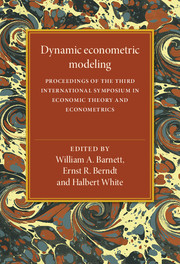 Dynamic Econometric Modeling
Dynamic Econometric Modeling Book contents
- Frontmatter
- Contents
- Editors' introduction
- List of contributors
- Part I Dynamic structural modeling
- Part II Linear time series modeling
- Part III Chaotic attractor modeling
- Part IV Applications
- 13 Investment and sales: some empirical evidence
- 14 Me and my shadow: estimating the size of the U.S. hidden economy from time series data
- 15 Estimating structural models of unemployment and job duration
15 - Estimating structural models of unemployment and job duration
Published online by Cambridge University Press: 03 May 2010
- Frontmatter
- Contents
- Editors' introduction
- List of contributors
- Part I Dynamic structural modeling
- Part II Linear time series modeling
- Part III Chaotic attractor modeling
- Part IV Applications
- 13 Investment and sales: some empirical evidence
- 14 Me and my shadow: estimating the size of the U.S. hidden economy from time series data
- 15 Estimating structural models of unemployment and job duration
Summary
Available theoretical models of unemployment and job duration are based on a dynamic formulation of an individual worker's job search and job–matching problems. In general versions of the theory, the individual anticipates future arrival of an uncertain sequence of employment opportunities, whether currently employed or not. The worker controls the transition process between employment states and jobs by choosing search and acceptance strategies that maximize expected wealth given current information. In other words, the strategy is the solution to a well–defined dynamic programming problem.
Given a model of this type, the properties of the probability distributions of both the length of time spent looking for an acceptable job while unemployed and, once employed, the length of the specific job spell are endogenously determined by the optimal strategy and the structure of the decision problem. Hence, observations on the completed unemployment and job spell lengths experienced by a sample of workers provide information about the problem's structure. The purpose of this chapter is to develop methods suggested by the theory that an econometrician might find useful for the purpose of estimating structural parameters from available observations on realized unemployment and job spell lengths and to test their potential usefulness using Monte Carlo techniques.
Although structural models of unemployment and job spell duration have been available for some time, there are few attempts to estimate them in the literature. Instead, ad hoc specifications of the duration hazards borrowed from the statistical literature on survival and reliability analysis are estimated.
- Type
- Chapter
- Information
- Dynamic Econometric ModelingProceedings of the Third International Symposium in Economic Theory and Econometrics, pp. 335 - 356Publisher: Cambridge University PressPrint publication year: 1988
- 15
- Cited by
